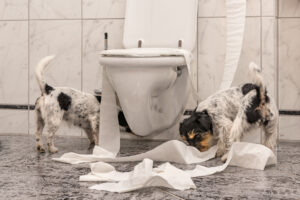All For Animals TV #72: Dealing with post-pandemic separation anxiety in DOGS

While having to stay and work from home during the Covid-19 crisis has been very stressful for people, it’s been great for pets, most of whom love having their people around. But as many of us go back to work and school in person, this can create problems for pets who’ve gotten used to the 24/7 routine of the last year. Whether the pet has been in the home for years or only recently joined the family, you may find your dog or cat won’t like it much — and will let you know with new, undesirable behaviors.
All For Animals TV spoke with animal behavior expert Marissa Sunny specifically about issues that might arise in dogs.(Our talk with Samantha Bell about cats is coming soon!)

Behaviors associated with separation anxiety in dogs:
- Barking, howling, or whining when you leave (not just in response to noises outside of the home), especially for longer than 30 seconds.
- Scratching or chewing at entrances and exits (doors/windows)
- Destructive behavior that only happens when the dog is alone
- Over-grooming or other self-harm or obsessive behaviors
- A change in appetite

Solutions and ways to prepare before you start being away from home more often during the day:
- Create a safe, comfortable place where they can have peaceful, relaxing alone time. This could be a crate or separate room, just make sure it’s the quietest part of the house.
- Provide them with enrichment that can be enjoyed independently, such as hidden treats in boxes, food puzzles, stuffed Kongs, etc.
- Play soothing music such as reggae, smooth jazz, or classical, or play the TV or radio to stations like the BBC or NPR while you’re gone to keep them from being startled by outside noises. You can also try a white noise machine.
- Reward your dog for calm, independent behavior (especially if they’re usually clingy). We tend to pay attention to dogs only when they’re active or even misbehaving. They should be rewarded for being calm and chill.
- Practice leaving for short periods of time to run essential errands or go for a walk:
-
- If your dog shows signs of panic, decrease the amount of time that you leave, even if for just a few seconds.
- If your dog barks or paws at the door when you leave, come back only when they’re quiet.
- If your dog has trouble being alone for even brief periods of time – consult a Certified Separation Anxiety Trainer (CSAT) who usually due virtual consultations.
For more information and pet behavior tips, visit www.bestfriends.org.






